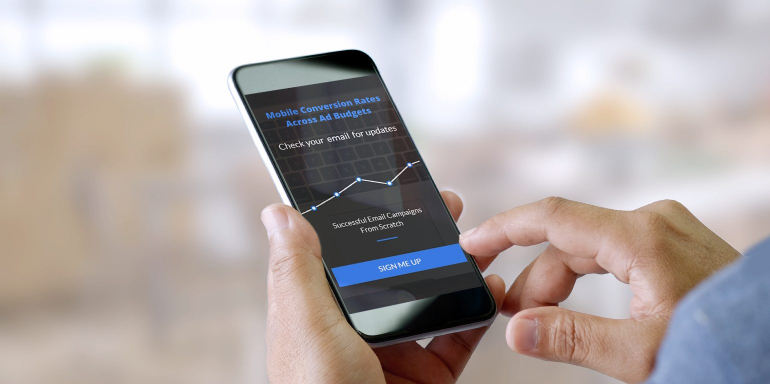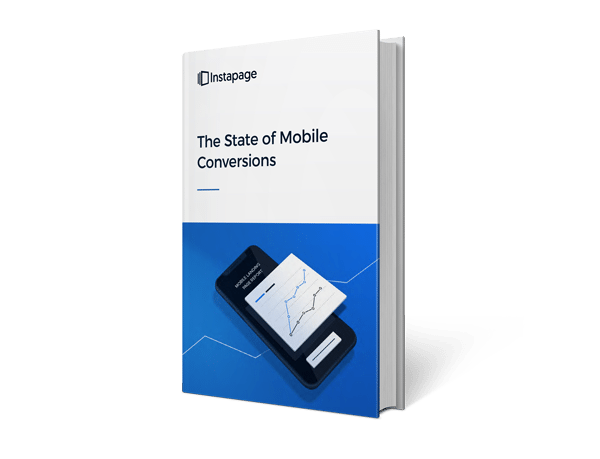What could you do with a bigger budget? If you’re a digital advertiser, chances are you’ve wondered at some point.
And so have we. Is there a relationship between spend and return? Do you have to give more to get more?
On your behalf, we did some digging to find out.
In the State of Mobile Conversions Report, 41 million anonymous visitors to 45,000 active Instapage post-click landing pages divulged much about:
- Why mobile post-click landing pages are integral to improving conversion rates
- post-click landing page conversion rates across industries
- Factors that contribute to a high-performing mobile post-click landing page
- Mobile conversion rates across multiple qualifiers
- The post-click landing page software landscape and what to look for in a solution
Get your copy of the Instapage post-click landing page report on mobile data here:
Hypotheses about conversion rates across ad budgets
What do you think happens to conversion rates as ad budget increases?
Do they grow? Shrink? Stay the same?
We weren’t 100% sure, but one can make logical hypotheses for all three:
Grow
This seems the most obvious. With a bigger budget comes more resources to spend on: conversion optimization tools, marketing automation that focuses hyper-targeted advertising like post-click landing page software and retargeting platforms. And that, ultimately, will lead to higher conversion rates because relevance is the foundation of any good marketing campaign. The more relevant an offer, ad, and post-click landing page to its audience, the more likely prospects are to claim it.
Stay the same
Could this happen? Could you spend more and not see your conversion rates move upward? Absolutely. “Ad budget” is a general term. Just because somebody has a bigger budget, it doesn’t mean they’re spending it on increasing their conversion rates. They could be allocating more to traffic or boosting customer lifetime value. Conversion rate is not a metric you should always be focused on.
Decrease
Of all three, this seems the most unlikely, right? That you could have a bigger ad budget and see your conversion rates decrease…
But, unless you’re spending on optimization services or tools to boost conversion rate, then it’s more likely than you’d think. If you’re spending on increasing traffic to key post-click landing pages, for example, it’s likely the conversion rates of those post-click landing pages will decrease. It’s also likely the conversion rate of your ads will decrease. This phenomenon is known as regression to the mean. It works this way:
When you start driving traffic to an ad or a post-click landing page, initially your conversion rate may look great: the first visitor converts, the second one too, and the third, and the fourth. At that moment, your conversion rate is 100%. You think to yourself, “This is a killer post-click landing page. I’m going to spend some of my budget on getting more people there.”
So you do, and then the tenth visitor comes, and the twentieth, hundredth, thousandth. But your post-click landing page isn’t converting anywhere near 100% anymore. That rate has plummeted to just 3%. Five out of the first five visitors converted, but only 25 out of the next 995 claimed your offer. What happened?
Well, your post-click landing page didn’t get worse. Your sample size simply grew as more visitors landed on the page. And the more samples you gain, the closer your conversion rate will move toward the mean — its average, expected conversion rate. No post-click landing page should be expected to convert at 100%. A 97% dip in conversion rate might seem like a catastrophic occurrence, but 3% is much closer to industry averages.
However, as you’ll see below, 3% should not be considered the industry average anymore.
The results are in: Conversion rates across budgets
We had our hypotheses, and now you probably have yours. So how do they stand up to the actual numbers? Take a look:

According to respondents, here’s the breakdown of conversion rates across monthly advertising budgets:
- Those with monthly ad budgets below $1,000 reported mobile conversion rates lowest among respondents at 17.8%
- Those with monthly ad budgets between $1,001 and $10,000 reported the second lowest mobile conversion rates among respondents at 19.63%.
- Those with monthly ad budgets between $10,001 and $50,000 reported the highest mobile conversion rates among respondents at 24.94%.
- Those with monthly ad budgets higher than $50,000 reported the second highest mobile conversion rates among all respondents at 21.1%
There seem to be some strange trends here. Why might conversion rates peak between those with $10,001 and $50,000 to spend? Why were they lowest among those with the least money to spent?
A few reasons could be what we touched on above:
First, not everybody prioritizes post-click landing page conversion rate. This is especially true of small businesses.
Consider this hypothetical: You have a small ad budget of less than $1,000/month. Your post-click landing page conversion rate is 5% and you are generating, on average, 1,000 visits to that post-click landing page per week. That means you’re converting around 50 prospects per week, 200 per month.
You could spend a valuable portion of your budget doubling your conversion rate to 10%, which would boost the number of prospects you convert to 100 weekly, 400 monthly… or you could spend that money driving 2,000 more visits to your post-click landing page weekly — which would result in 150 conversions per week, or around 600 per month.
Remember — doubling your conversion rate is rare. Sustained lifts in conversion rate are usually very very small. And when you’re generating a low amount of traffic, those lifts will not do much to your bottom line. This is likely why conversion rates are not prioritized at businesses with smaller ad budgets.
The middle two groups — businesses with budgets between $1,001 and $50,000 are the ones likely to see bottom-line benefits with small and sustainable lifts. We can’t be sure, but it’s possible these companies are located in a sweet spot when it comes to size, budget, staff — with just enough of everything to manage campaigns at scale. As in, there aren’t so many ads or post-click landing pages that optimizers are overwhelmed by A/B testing to find the highest performer.
The last group — those with the biggest advertising budget. You might assume they’d have the highest mobile post-click landing page conversion rates since they have the most to spend on tools and teams to optimize everything.
However, it’s also possible that many businesses of this size do not spend on the resources necessary to keep up with what’s likely a massive advertising initiative. When you’re publishing countless ads and post-click landing pages, and you don’t have the staff to continually test and run winners easily, you’re likely reusing pages for “similar” campaigns, you’re not making optimizations, and the result is a lower overall conversion rate.
The results of our study are not meant to imply that businesses on the low end (17.8%) should feel bad by any means. 17.8% is a great conversion rate, especially when you consider the previous industry reported average was approximately 3%. post-click landing pages play a critical role for all digital advertisers regardless of ad spend as part of the post-click landing page.
Learn more from the Instapage post-click landing page report
These are just a few insights from the Instapage post-click landing page report on mobile conversion rates. To learn more about:
- Mobile conversion strategies
- Mobile conversion rate by geographic location
- And all the other little-known details that impact mobile conversion rate…
Get your copy of the Instapage State of Mobile Conversions report here.

See the Instapage Enterprise Plan in Action.
Demo includes AdMap™, Personalization, AMP,
Global Blocks, heatmaps & more.

